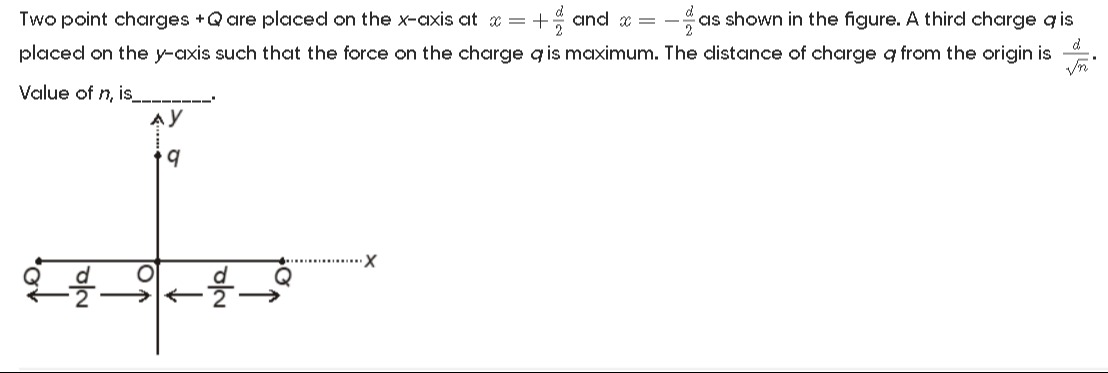Question
Question: Two point charges +Q are placed on the x-axis at $x=+\frac{d}{2}$ and $x=-\frac{d}{2}$ as shown in t...
Two point charges +Q are placed on the x-axis at x=+2d and x=−2d as shown in the figure. A third charge q is placed on the y-axis such that the force on the charge q is maximum. The distance of charge q from the origin is nd. Value of n, is ________.

Answer
8
Explanation
Solution
To determine the distance from the origin where the force on charge q is maximum, we follow these steps:
-
Define coordinates and forces:
- The two charges +Q are located at P1(−2d,0) and P2(+2d,0).
- The charge q is placed on the y-axis at Pq(0,y).
- The distance from each +Q charge to q is r=(2d)2+y2.
-
Calculate the force due to each +Q charge:
- The magnitude of the force exerted by each +Q charge on q is given by Coulomb's Law: FQ=kr2Qq=k(2d)2+y2Qq where k=4πϵ01 is Coulomb's constant.
-
Resolve forces into components:
- Let θ be the angle that the line connecting a +Q charge to q makes with the y-axis.
- From the geometry, cosθ=ry=(2d)2+y2y.
- Due to symmetry, the x-components of the forces from P1 and P2 on q will cancel out.
- The y-components will add up. The net force Fnet on q will be along the y-axis.
- Fnet=2FQcosθ
- Substitute the expressions for FQ and cosθ: Fnet=2(k(2d)2+y2Qq)((2d)2+y2y) Fnet=((2d)2+y2)3/22kQqy
-
Find the condition for maximum force:
- To find the value of y for which Fnet is maximum, we differentiate Fnet with respect to y and set the derivative to zero (dFnet/dy=0).
- Let C=2kQq and a=2d. So, Fnet=C(a2+y2)3/2y.
- Using the quotient rule or product rule for differentiation: dydFnet=C[((a2+y2)3/2)2(a2+y2)3/2⋅1−y⋅23(a2+y2)1/2⋅(2y)] dydFnet=C[(a2+y2)3(a2+y2)3/2−3y2(a2+y2)1/2]
- For Fnet to be maximum, the numerator must be zero: (a2+y2)3/2−3y2(a2+y2)1/2=0
- Divide by (a2+y2)1/2 (since it's non-zero): (a2+y2)−3y2=0 a2−2y2=0 a2=2y2 y2=2a2
- Substitute a=2d: y2=2(d/2)2=2d2/4=8d2
- The distance of charge q from the origin is ∣y∣: ∣y∣=8d2=8d
-
Compare with the given format:
- The problem states that the distance is nd.
- Comparing our result 8d with nd, we get: n=8 n=8
